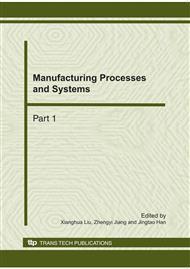p.595
p.601
p.606
p.611
p.615
p.621
p.628
p.633
p.640
The Research on Thermal-Mechanical Coupling Simulation of Steam Turbine Vane Material’s Cutting Process
Abstract:
In order to explore the cutting rules of the 43-inch vane material --1Cr12Ni3Mo2VNbN on the turbine vane, and research the stress in cutting area, the strain as well as the temperature distribution and the variation, providing the reference data for the large-scale vane-root milling cutter's geometric parameter design and the cutting parameter optimization, the authors employed ANSYS / LS-DYNA finite element method to simulate and research the cutting process of the vane material. The authors adopted the two-dimensional plane element 2D SOLID l62 of the single-point integration Lagrange algorithm to establish the finite element cutting model, and established the Cowper-Symonds constitutive models based on the vane material, applied the 2D-r adaptive meshing to simulate the separation of the chip and workpiece. Obtain the distribution and rules of the stress, the strain as well as the temperature in the cutting area, and greatly shorten the period of the vane root milling cutter’s designing and trial-production.
Info:
Periodical:
Pages:
615-620
Citation:
Online since:
October 2010
Authors:
Price:
Сopyright:
© 2011 Trans Tech Publications Ltd. All Rights Reserved
Share:
Citation:


